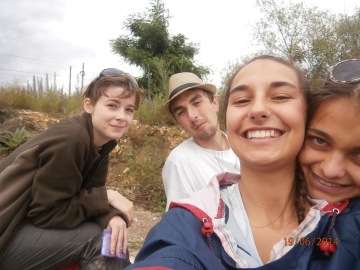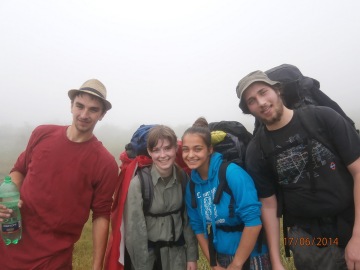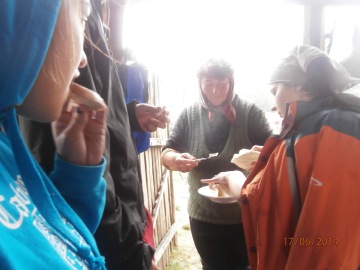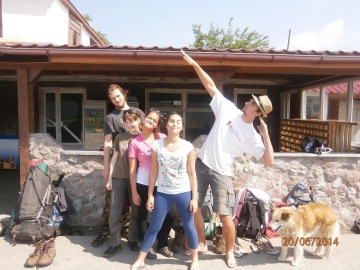DofE Gold expedition in Banát

Our expedition started shortly after we arrived to Banat. Our aim was to explore the lifestyle of Czechs who came to Banat some 200 years ago and the nature as well.
We - David, Matyas, Dominika, Kristina and Sara - started on Tuesday, 17th June 2014. We started from the Czech village of Eibenthal and continued upwards to a hill Znamana. The weather was terrible - it was so foggy that we could not see more than 15 meters and the wetness of the grass (it rained the day before) caused that our trousers and shoes were soaked. On top of that, we got lost. However, we found the yellow sign again. We went around a herd of cows with a bull which mooed at us, so we continued very quickly and arrived at a cow’s shelter. There we met two local Romanian women who cared about the cows and also two women from another Czech village, Bigr. We tasted cheese that was made there, hid from the rain and observed how the staff tried to make a bull (probably the one that scared us) mate with a cow belonging to the women from Bigr. Even though it was fascinating, it did not work well and the rain stopped, so the women from Bigr decided to go home. Since our journey was in the same direction, we went with them (and the cow), through a beech forest. The older woman, Veruna, was very talkative, so we heard a lot of information from her - how she visited the Czech Republic and what her favourite painkiller was. It was about 13 km to Bigar, but the quite skinny cow went quickly. In Bigr, we went around the church and a shop and continued around few crosses and dumps. It was late and it started to rain again, so we quickly found a place and built our tents. When the tents were standing, it stopped raining, so we made our dinner and decided that we will not be able to go according to plan the next day.
On Wednesday, we were finally able to have a better view around the landscape: we were on a hill and the mist dissolved a little shortly after we started in the morning. We continued down the hill to a double ford, a place where we were supposed to sleep. There were many mosquitos, so we were glad that we did not sleep there. We continued along a path next to a stream. The path was really overgrown - we thought that we were the first people to go this way in this year. Then the path left the valley and went upwards. The hill was of such a nature that we thought that we would see the top of it (which was nearby), but when we reached it, we saw another top. Somewhere on the hill we had our lunch and later the way finally started to go down. However, it was quite muddy and the slope was steep, so some of us were falling so often that one could say that they were sliding. Under the hill there was a crossing of the red tourist path with a road and both ways led to the next Czech village, Ravensca. The red path was a bit shorter, but led through two other hills, so we decided to go on the road. We also decided that in the wet weather, we would not make it according to the plan, so we sent a message to Mr Kaspar to pick us in Sopotu Nou. On the road, we met a group of forest workers. One of them was from Ravensca and told us to go through a shortcut, a way that was made by the forest workers. We listened to him and went that way. Since the way was full of mud, it was probably one of the most memorable moments of the expedition. It was so muddy that you could not stand for too long on one place because you would get stuck in it up to your knees. The hill was also quite steep, making the way even more demanding. When we finally got to the end of the muddy, unforgettable path, we were on a top of the hill, on a meadow. We saw a chalet with mowed grass nearby, so we knocked on a window and asked the man who was living there if we could build our tents there. He agreed and told us that he would accompany us tomorrow morning to Ravensca, but we needed to go early. So we built our tents and fell asleep.
The next day, we went with the man to Ravensca. He was walking very quickly, but still managed to talk. We went on a ridge, with pastures all around us and a wonderful view. Then we arrived to Ravensca and talked a bit with the local people while we were resting. We got a message from Mr Kaspar informing us that the bus cannot go to Sopotu Nou, but they will pick us up at 11 in Liubcova. We thought that he meant 11 o’clock this day, so we hurried up as fast as we could down to the Danube valley. There we finally got another message, saying that the bus will come at 11 on Friday, not Thursday. In Liubcova, we tried to find a suitable place to build our tents. It was a bit more difficult than up in the hills, but we succeeded. After a rest we went by the Danube to ancient Rome ruins. It was a bit disappointing because we hoped to see more than just foundations of four walls, but on our way back we sat by the water and enjoyed the view - the river and wonderfully looking Serbian hills from the opposite shore. We also saw a few dead snakes, reminding us about vipera ammodytes, the most dangerous European snake that is present in Banat. Then we gathered all together in one tent in order to talk with each other a bit, but we were so tired that we fell asleep, so we decided to go into our own tents and sleeping bags.
Next morning, we packed our things and went to a nearby petrol station to evaluate our experiences. The sun was shining (finally) and the bus came, ending our expedition.
Here you can see the photogallery.
Sára Poštulková


